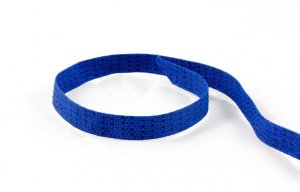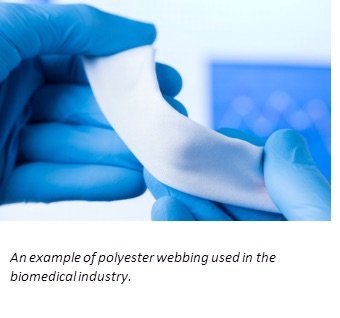
BRM announces E-Webbings
Closing of Berry-compliant yarn manufacturers disrupts market

3rd August 2020
Innovation in Textiles
|
Bally, PA
Key specialty polyester webbings applications
“Polyester webbings are manufactured from polyester yarn, which is dimensionally stable and has low moisture regain. The fibre also has a low elongation under load property that sets it apart from other standard fibres of its class, like nylon (PA6 and -PA6.6) and polypropylene. It is tough, hydrophobic, and resistant to degradation, giving it a longer useful shelf life, BRM’s Ted Fetterman explains.
“Polyester webbings are used in hundreds of applications. Seatbelts in automotive, commercial aviation, and military vehicles and aircraft applications is the largest market sector. This is a generally commoditized market where large volumes, limited colour options, and very low prices dominate.”
“Another key application is for retractors used in military and safety/rescue applications to secure on-aircraft personnel. The retractors are generally inertia reels that allow for mobility under normal conditions; the webbing connects the user to the aircraft. When an abrupt force is applied, the reel locks the personnel into place. These webbing materials are highly engineered for the application. Consistent construction to rigid standards is required for consistent performance in end-item use. Materials that vary widely from specifications cause the reel to malfunction, exposing the user to an unsafe condition,” Mr Fetterman says.
“Other specialty webbing applications include tie-downs, e-textiles, wearable electronics, flight suits, pet products, cargo webbing, and life rafts, as well as hoses, bags and harnesses. The overall market trend towards enhanced passengers and crew safety is increasing demand for safety-related webbings applications. Another growing market is medical devices, where the polyester webbing material is prized for its biocompatibility.”
Manufacturers step up to produce domestic supplies of polyester woven webbing
Ted Fetterman continues: “Under the Berry Amendment, all textile components for Department of Defense (DOD) contracts of a certain size must be manufactured in the United States. The closures of domestic manufacturers of polyester yarn had many manufacturers scrambling to find a US source for customers with government contracts requiring Berry-compliant materials. Lead-times lengthened and some yarn manufacturers told panicking customers that a US source was unavailable. Several polyester webbing manufacturers applied for a Domestic Not Available Deviation (DNAD) designation.”
“The idea that the U.S. would have to rely on China, which maintains 70 % of the world’s polyester capacity, did not sit well amongst many domestic manufacturers. This concern encouraged US manufacturers to add polyester to their lines. There is always a development lag time before production can begin, but several have now entered the market.”
After identifying newly established domestic polyester yarn suppliers, Bally Ribbon Mills committed to establishing itself as a 100% Berry-compliant manufacturer of polyester webbings. The company has always placed a high importance on utilizing domestic yarn sources. Since the quality of the domestic raw material is higher than imported counterparts, the company says, it stands to reason that the webbing manufactured is of a higher quality. This enables more efficient manufacturing processes and provides superior products, BRM adds.
In addition to being Berry-compliant, the polyester webbings and tapes are tested and certified for compliance with a range of commercial and military specifications, including Mil/PIA-W-25361, AA55242, SAE AS8043, and British Standards (BS). Performance to these specifications and standards is critical to the end use application. Not meeting specifications can cause performance failure that could cost lives.
Several of these standards have extremely stringent elongation requirements for dyed material that can be difficult to meet. In some cases, BRM began entering these markets after others dropped out and military requirements called out for Berry-compliant yarn. For example, the SAE AS8043 specification calls for 20% elongation at 2,500 lbs. for polyester seat belt webbing. After working with customers, BRM succeeded in meeting the elongation requirement.
As an added bonus, end customers can take advantage of BRM’s low minimums (1,000 yards per colour) to purchase unique seatbelt colours. The polyester yarn dying process requires expensive and highly specialized equipment. BRM technology enables the company to run smaller quantities of higher quality specialty colours; the yarns also feature very high dye penetration, giving it a high level of colour fastness and longer fade-resistance. Due to the commoditized nature of much of the seat belt market, most other manufacturers require much larger minimums, 10,000-20,000 yards per colour.
Colour matching is an important part of the process, with the ability to colour match to a customer supplied sample. BRM scans the sample and duplicates the colour by creating a master batch formula and new standard sample that is sent to the customer for approval. The standards are maintained in a controlled file and used to match subsequent lots. All samples and dye lots are measured using a spectrophotometer to ensure that the dye lots match the standard numerical to within 1(delta) of a 3-plane graphical model of yellow, blue, green, and light/dark. Color shades are also checked using the naked eye but with a controlled light source. Full testing with documentation is supplied, with a variety of available treatment offerings.
Helping to make the process even more rigorous is a proprietary polyester matrix, a searchable internal database tool with information on thousands of textiles collected and organized for comparative study. Every material that comes through the plant is measured and tested using ASTM testing methods. Records are kept of physical parameters like width, fibre content, tensile strength, thickness, weight, elongation, resistance to abrasion, and resistance to weathering.
Polyester webbing developed with rigorous project planning, control and feasibility process BRM follows a rigorous project planning, control and feasibility (PPCF) process that allows experts to engineer products specific to customer requirements or specifications. Several new product development polyester items involved converting European specifications and materials to meet Berry-compliant requirements for US military applications. The company has developed Berry-compliant polyester webbing for seatbelts used as lap belts in commercial and private airliners; harness webbing used in restraints for the military; ejection seat webbing for military air crafts; and polyester used in tie-down straps.
According to BRM, an interesting example is a flight suit application for which the customer required Berry-compliant webbing that also met British Standard specs for use in low elongation tensile structures within the suit. The company analysed the samples as part of the PPCF process, then submitted it to the research and development team, which analysed the samples to review its construction and compare it with the spec. From there the process ran through other pre-development steps, including a cost evaluation. The quote was issued and accepted, an order placed, and the job was scheduled.
The new Integrated Aircrew Ensemble (IAE) flight suit, designed to improve aircrew comfort and protection, will be integrated into various flight systems and used in all ejection seat aircraft. Likely to be adopted by the military over the long term, it is currently being issued to US aircrews, beginning with the F-22. [1] This exciting project represents an excellent example of the uses of innovative polyester webbing.
Another example is a structural polyester tie-down for temporary medical and first responder shelters being designed during the COVID-19 pandemic. BRM secured the contract in part because of the changes it instituted to adapt to new conditions arising out of the COVID-19 outbreak.
The original inquiry came at the end of the March 2020 national business shut down. BRM had already ceased factory operations to ensure workforce safety but was considered an essential business since it manufactures textile materials for the US military, law enforcement, and medical devices.
The company had to meet its contractual obligations while still maintaining a safe working environment for employees. They were also concerned that any positive test result might set back their production schedules indefinitely until they could resolve contamination and complete containment traceability studies. The factory was running at 75% of pre-COVID productivity and the entire sales, customer service, and R&D team was working from home.
Before COVID, the entire PPCF design review process was paper based, routed sequentially through R&D, manufacturing, purchasing, quality, and costing, with each department responsible for identifying risks and project acceptability. Six routing paths could be used, based on the varying requirement of core customers, medical products, and aerospace applications. The process could take up to two weeks to complete.
Under the new normal imposed under COVID, this system was transformed to a completely electronic routing system completed with sequential review. The new system succeeded in shortening lead times from 10-14 days to 3-5 days. Furthermore, the system allows the salesperson initiating the process to view the routing status at any time and enables others to intercede at any point to solve any immediate problems.
“BRM eventually won the polyester business for the shelters for two key reasons,” Fetterman explains. “First of all, the customer wanted to ‘reshore’ the supply chain, and BRM provided a Made in the USA solution. Secondly, the quick, automated professional response to the inquiry during the height of a national crisis provided comfort to the new customer. After the customer satisfied its immediate demand requirements, they added on blanket order requirements that extend into 2021.”
“Rather than going back to its old ways of scoping out new business, the company will continue to use the positive changes made under difficult conditions to respond to a national emergency as a model for conducting business in the future have turned into the model that BRM plans to use in the future.”

Business intelligence for the fibre, textiles and apparel industries: technologies, innovations, markets, investments, trade policy, sourcing, strategy...
Find out more